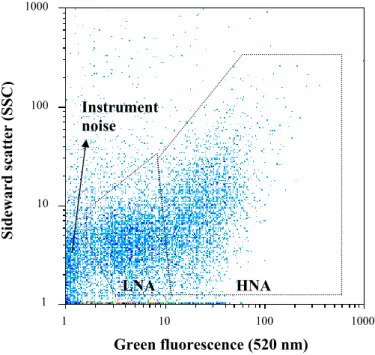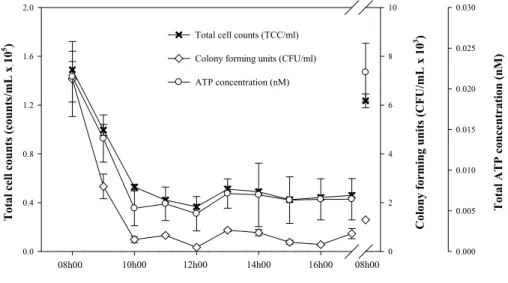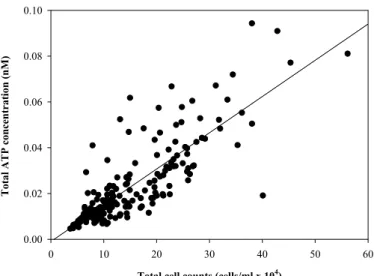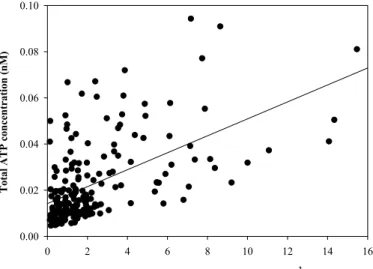DWESD
1, 71–86, 2008Correlations between methods to assess
microbial water quality
E. Siebel et al.
Title Page
Abstract Introduction
Conclusions References
Tables Figures
◭ ◮
◭ ◮
Back Close
Full Screen / Esc
Printer-friendly Version
Interactive Discussion
Drink. Water Eng. Sci. Discuss., 1, 71–86, 2008 www.drink-water-eng-sci-discuss.net/1/71/2008/ © Author(s) 2008. This work is distributed under the Creative Commons Attribution 3.0 License.
Drinking Water Engineering and Science Discussions
Drinking Water Engineering and Science Discussionsis the access reviewed discussion forum ofDrinking Water Engineering and Science
Correlations between total cell
concentration, total adenosine
tri-phosphate concentration and
heterotrophic plate counts during
microbial monitoring of drinking water
E. Siebel1, Y. Wang1,2, T. Egli1,2, and F. Hammes1
1
Swiss Federal Institute of Aquatic Science and Technology (Eawag), ¨Uberlandstr. 133, 8600 D ¨ubendorf, Switzerland
2
Institute of Biogeochemistry and Pollutant Dynamics, ETH Z ¨urich, 8092 Z ¨urich, Switzerland
Received: 31 January 2008 – Accepted: 6 February 2008 – Published: 11 February 2008
Correspondence to: F. Hammes (frederik.hammes@eawag.ch)
DWESD
1, 71–86, 2008Correlations between methods to assess
microbial water quality
E. Siebel et al.
Title Page
Abstract Introduction
Conclusions References
Tables Figures
◭ ◮
◭ ◮
Back Close
Full Screen / Esc
Printer-friendly Version
Interactive Discussion
Abstract
The general microbial quality of drinking water is normally monitored by heterotrophic plate counts (HPC). This method has been used for more than 100 years and is recom-mended in drinking water guidelines. However, the HPC method is significantly hand-icapped because it is time-consuming and restricted to culturable bacteria. Recently,
5
rapid and accurate detection methods have emerged, such as adenosine tri-phosphate (ATP) measurements to assess microbial activity in drinking water, and flow cytometry (FCM) to determine the total cell concentration (TCC). It is necessary and important for drinking water quality control to understand the relationships among the conventional and new methods. In the current study, all three methods were applied to 200 drinking
10
water samples obtained from two local buildings connected to the same distribution system. Samples were taken both on normal working days and weekends, and the correlations between the different microbiological parameters were determined. The results showed that the rapid determination methods (i.e., FCM and ATP) correlated significantly (R2=0.69), but only a weak correlation (R2=0.31) was observed between
15
the rapid methods and conventional HPC data. With respect to drinking water monitor-ing, both FCM and ATP measurements were confirmed to be useful and complimentary parameters for rapid assessing of drinking water microbial quality.
1 Introduction
For more than 100 years, microbial characterization of drinking water has relied on
20
heterotrophic plate counts (HPC) (Sartory, 2004). This method is used world-wide for monitoring drinking water quality in the distribution network and for assessing the efficacy of treatment steps (Allen et al., 2004; Reasoner and Geldreich, 1985). In Switzerland the statutory limit of HPC bacteria has been set to 20 colony forming units per ml (CFU/ml) after treatment, and to 300 CFU/ml within the distribution system (HyV,
25
DWESD
1, 71–86, 2008Correlations between methods to assess
microbial water quality
E. Siebel et al.
Title Page
Abstract Introduction
Conclusions References
Tables Figures
◭ ◮
◭ ◮
Back Close
Full Screen / Esc
Printer-friendly Version
Interactive Discussion
Despite the common usage of HPC, it is reported that HPC bacterial numbers can vary widely in drinking water distribution networks (Allen et al., 2004; Pepper et al., 2004). It has been discussed previously that HPC results are influenced by various factors such as cultivation media, incubation temperature and the selective culturability of natural bacteria (Hammes et al., 2008; Sartory, 2004). Moreover, the HPC method is
time-5
consuming, requiring usually 3–7 days before results are available. There is thus a niche for the development of rapid, easy and accurate methods to quantify bacteria in drinking water.
The development of fluorescent staining methods facilitated the accurate measure-ment of the total cell concentration (TCC) with epi-fluorescence microscopy,
laser-10
scanning microscopy and flow cytometry (Rinta-Kanto et al., 2004; Hammes et al., 2008). The ability to enumerate the complete bacterial cell concentration has revealed a huge discrepancy between concentrations of cells detected with conventional HPC and with TCC methods in aquatic environments. TCC measurement with flow cytome-try has clear benefits: it is fast, highly reproducible and it detects all bacteria
irrespec-15
tive of their culturability (Hammes et al., 2008). We have also previously demonstrated the value of this parameter when describing microbial events that occur during drinking water treatment (Hammes et al., 2008). An alternative method gaining prominence is adenosine tri-phosphate (ATP) measurements. It is a rapid and easy method for the detection of viable bacteria in drinking water (Hammes et al., 2008) and has previously
20
been correlated to conventional HPC data (Deininger and Lee, 2001; Delahaye et al., 2003). However, ATP is not yet widely used in the drinking water industry, due to a lack of knowledge on average ATP concentrations in natural bacteria. This is needed to un-derstand ATP measurements and to correlate ATP data to biomass. For new methods to gain acceptance amongst practitioners, it is essential to understand the relationship
25
(if there is any) among the various methods.
DWESD
1, 71–86, 2008Correlations between methods to assess
microbial water quality
E. Siebel et al.
Title Page
Abstract Introduction
Conclusions References
Tables Figures
◭ ◮
◭ ◮
Back Close
Full Screen / Esc
Printer-friendly Version
Interactive Discussion
two separate office buildings during a normal working day and a weekend day. Their correlations were determined and evaluated.
2 Materials and methods
2.1 Sampling
Drinking water samples were collected from two buildings at our research facility
5
(Eawag, D ¨ubendorf, Switzerland). Sampling from both buildings took place on two separate days, one working day (Wednesday) and one weekend day (Sunday) to ob-serve the effect of regular and non-regular usage. Samples were taken from 8 a.m. to 5 p.m. at one hour intervals and at 8 a.m. on the following morning to account for temporal changes during a day. Tap water from 10 separate floors in both buildings
10
was sampled directly into sterile 15 ml Falcon tubes without any prior water flushing. Samples were processed directly after sampling.
2.2 Flow cytometric total cell counts measurements
To measure the total cell counts (TCC), 900µl of the water sample was stained with 9µl of SYBR Green I nucleic acid stain (1:100 diluted in filtered DMSO; Invitrogen™,
15
Oregon, USA) and incubated in the dark for 10 min before measuring with a Partec CyFlow Space flow cytometer (Partec GmbH, M ¨unster, Germany). Flow cytometric measurements were performed as described previously (Hammes et al., 2008). The Partec CyFlow Space is equipped with a volumetric counting hardware with a mea-sured quantification limit of <1000 cells/ml (Hammes et al., 2008). TCC were also
20
DWESD
1, 71–86, 2008Correlations between methods to assess
microbial water quality
E. Siebel et al.
Title Page
Abstract Introduction
Conclusions References
Tables Figures
◭ ◮
◭ ◮
Back Close
Full Screen / Esc
Printer-friendly Version
Interactive Discussion
2.3 Total ATP concentration
Total ATP concentration was determined as described in Berney et al. (2006) using the Promega Bac Titer-Glo Microbial Cell Viability Assay (Promega Corporation, Madison, WI, USA). All samples were measured in triplicate. A standard curve with dilutions of a known rATP standard (Promega Corporation) was completed before the experiments
5
and the total ATP concentration was calculated based on the standard curve. ATP-per-cell was calculated from total ATP measurements and flow cytometry measurements as follows:
ATP-per-cell (g/cell)=total ATP concentration (g/L)
cell concentration (cells/L) (1) 2.4 Heterotrophic plate counts (HPC)
10
HPC was performed according to the Swiss guidelines for drinking water (SLMB, 2000). In short, PCA agar plates (BBL Standard Methods Agar, MD, USA) were prepared fol-lowing instructions provided by the manufacturer. Serial dilutions of the water sam-ples were done in decimal steps in sterile 0.9% NaCl solution. 100µl of the sample were spread-plated from two dilutions (100 and 10−1), each in triplicate, to assess
15
methodological variation. The plates were incubated at 30◦C for 72 h. Colony form-ing units (CFU) were counted with an automatic plate reader (aCOLyte, SYNBIOSIS, Cambridge, UK).
3 Results and discussion
3.1 Overview of the measurements with different methods
20
DWESD
1, 71–86, 2008Correlations between methods to assess
microbial water quality
E. Siebel et al.
Title Page
Abstract Introduction
Conclusions References
Tables Figures
◭ ◮
◭ ◮
Back Close
Full Screen / Esc
Printer-friendly Version
Interactive Discussion
a total of 200 samples were collected and analyzed from two buildings over four sep-arate days. Total cell concentrations (TCC) from the drinking water samples varied in the range of 0.37–5.61×105cells/ml. The average TCC was 1.49(±0.91)×105cells/ml, which concurs with previous data reported for Swiss drinking water (Hammes et al., 2008). In general, if a tap was used frequently, TCC numbers were low, but slight
5
changes in bacterial concentrations could still be detected. In all samples analyzed, two specific bacterial clusters were observed on two dimensional FCM dot-plots, distin-guished by size (as measured with sideward scattered (SSC) light) and green fluores-cence intensity (520 nm) (Fig. 1). These two clusters represent the so-called low (LNA) and high (HNA) nucleic acid content bacteria, which have been commonly observed in
10
seawater and freshwater with flow cytometry (Gasol et al., 1999; Lebaron et al., 2001). The concentrations of LNA and HNA bacteria in each sample were also counted sepa-rately. HNA bacteria, which previously have been related to microbial activity (Lebaron et al., 2001), represented usually about 60% of the TCC (data not shown) and through-out the study the HNA/LNA ratio remained constant, irrespective of the tap location,
15
sampling time or TCC variation. The standard deviation on triplicate FCM measure-ments was always below 5%, which is similar to former studies and underlines the high reproducibility of flow cytometric TCC measurements (Hammes et al., 2008; Hammes and Egli, 2005).
An alternative method for the characterization of bacteria in drinking water is
adeno-20
sine tri-phosphate (ATP) measurements (Deininger et al., 2001; Delahaye et al., 2003; Hammes et al., 2008). This method is rapid and easy to perform and its instrumenta-tion is rather affordable. The total ATP concentration for all samples was in the range of 0.005–0.094 nM ATP and the average ATP concentration was 0.023 (±0.017) nM ATP. Based on the TCC from flow cytometric measurements, the average cellular ATP
25
DWESD
1, 71–86, 2008Correlations between methods to assess
microbial water quality
E. Siebel et al.
Title Page
Abstract Introduction
Conclusions References
Tables Figures
◭ ◮
◭ ◮
Back Close
Full Screen / Esc
Printer-friendly Version
Interactive Discussion
ATP-per-cell value is that it can be used for converting ATP data to bacterial concen-trations. However, it is noted that the value reported in this study makes the broad assumption that all the cells detected with FCM were alive and containing a similar ATP concentration. With respect to reproducibility, the average standard deviation of all the ATP data was 13%, which is close to deviation values in other studies (Hammes
5
et al., 2008; Velten et al., 2007).
Conventional heterotrophic plate counts (HPC) results were on average two orders of magnitude lower than the TCC from flow cytometric measurements. No more than 8.6% (average 1.6%) of the TCC were detected with HPC. The average concentration of HPC was 2.28(±0.32)×103CFU/ml. Heterotrophic bacteria usually form a fraction
10
below 1% of total cell counts (van der Kooij, 2003; Hammes et al., 2008). Based on this value and referring to the Swiss guidelines of 300 CFU/ml for drinking water (HyV, 2006; SLMB, 2000), the obtained values were about 10-times higher in this particular distribution system than expected. The reason for such an increase might be regrowth; both planktonic and biofilm bacteria within the building’s distribution system and also
15
individual taps might affect the water quality (Pepper et al., 2004; van der Kooij, 2003). The average standard deviation of 14% is reasonable, but significantly higher com-pared to a constant error below 5% in flow cytometric TCC measurements.
3.2 Data from one representative tap
The changes and relationships among all three parameters from one representative
20
tap of Building 1 during a normal working day are shown in Fig. 2. A rapid decrease in TCC and HPC along with the total ATP concentration was observed. It is evident that all three methods rendered the highest values at 8 a.m., which is attributed to regrowth during overnight stagnation in the tap. All values decreased until 10 a.m., linked to reg-ular use of the taps before stabilizing during the day and again increasing overnight.
25
concentra-DWESD
1, 71–86, 2008Correlations between methods to assess
microbial water quality
E. Siebel et al.
Title Page
Abstract Introduction
Conclusions References
Tables Figures
◭ ◮
◭ ◮
Back Close
Full Screen / Esc
Printer-friendly Version
Interactive Discussion
tions (R2=0.96;n=11), while correlations between HPC and TCC (R2=0.72) and HPC and ATP (R2=0.56) were also recorded. These results showed that both rapid meth-ods (TCC and ATP) can detect the similar pattern as the conventional HPC method, but with the clear advantage of being fast, accurate and reproducible. Additionally we observed that small changes in HPC data were also detected by flow cytometry even
5
though there were two orders of magnitude difference in the actual values (Fig. 2). However, it should be pointed out that Fig. 2 exemplifies an ideal course of data points. Results from other floors had often more variations in daily changes, and amongst the various parameters.
3.3 Overall correlations among the three different parameters
10
Despite of the above-mentioned differences between the different buildings, floors and sampling days, the overall TCC and ATP data correlated very well with each other (R2=0.69) and had a high statistical significance (p≪0.001; n=200) when all data were considered (Fig. 3). However, there is also an apparent difference between the TCC and ATP measurements. This may lead to a general question such as: why would
15
ATP correlate or not correlate with TCC? Most likely, ATP would correlate well with TCC if most of the cells are alive and contain similar amounts of ATP, expecting a correlation coefficient close to 1. Evidently this is not the case and can be explained with various reasons. The uncertainty of ATP measurements (R2=0.696=1) towards TCC is probably not related to the error of either method, but occurs because different bacterial species
20
and different viability states of bacterial cells could influence individual cellular ATP concentrations. In fact, in a separate study we have shown that an even better corre-lation is found between ATP and the fraction of esterase-positive (CFDA-stained) cells in drinking water1. Nevertheless, the combination of TCC and ATP methods gives a complementary overall picture of the microbial quality in the drinking water distribution
25
system.
1
DWESD
1, 71–86, 2008Correlations between methods to assess
microbial water quality
E. Siebel et al.
Title Page
Abstract Introduction
Conclusions References
Tables Figures
◭ ◮
◭ ◮
Back Close
Full Screen / Esc
Printer-friendly Version
Interactive Discussion
Furthermore, we have also observed a similar overall correlation between HNA bac-teria and ATP (R2=0.67) (Table 1). It has been suggested that the HNA fraction gives a representation of the active bacterial population in a water sample (Gasol et al., 1999; Lebaron et al., 2001). The fact that the correlation with ATP has not improved when compared to HNA (opposed to TCC), contradicts this opinion to some extent,
5
and suggests that a mere HNA/LNA flow cytometric separation might be inadequate to interpret bacterial viability and activity in a drinking water sample. In addition, the consistent presence of LNA bacteria at high cell concentrations (40% of TCC) in the drinking water distribution system, indicates that this group of bacteria may also con-tribute to the bacterial activity.
10
In comparison with the strong correlation between TCC and ATP, correlation coeffi -cients between HPC vs. ATP (R2=0.31) and HPC vs. TCC (R2=0.36) were significantly lower, also when the data were separated to track possible distinctive changes day-wise and/or building-day-wise (Table 1). The correlation between ATP and HPC (R2=0.31; Fig. 4) is similar to that reported by Delahaye et al. (2003) even though different
culti-15
vation methods were used in the latter study. Both the studies of Delahaye et al. (2003) and Deininger and Lee (2001) concluded that rapid ATP measurement is a valuable drinking water parameter, based on the correlation thereof to conventional HPC data. Though our study comes to the same conclusion about ATP measurements, the data presented in Fig. 3, 4 and Table 1 clearly suggest that ATP correlates more
accu-20
rately to TCC than to HPC. We believe that this is a direct result of the selective nature of the HPC method, where only a small percentage of the viable (and thus ATP-containing) bacteria in a water sample can be cultivated on synthetic media under selective laboratory-defined conditions (Hammes et al., 2008)
4 Conclusions
25
DWESD
1, 71–86, 2008Correlations between methods to assess
microbial water quality
E. Siebel et al.
Title Page
Abstract Introduction
Conclusions References
Tables Figures
◭ ◮
◭ ◮
Back Close
Full Screen / Esc
Printer-friendly Version
Interactive Discussion
performed easily without the handicap of a selective trait such as culturability. In com-parison, the enumeration of heterotrophic bacteria is obviously more time and labour consuming. We have found that there is a strong correlation between TCC and the ATP data. Therefore, application of both methods simultaneously forms a powerful combination of rapid and accurate microbial characterization of drinking water.
5
Acknowledgements. The authors kindly acknowledge financial assistance from the Eawag Wave21 project and the 6th EU framework project TECHNEAU (018320).
References
Allen, M. J., Edberg, S. C., and Reasoner, D. J.: Heterotrophic plate count bacteria - what is their significance in drinking water?, Int. J. Food Microbiol., 92(3), 265–274, 2004.
10
Berney, M., Weilenmann, H. U., and Egli, T.: Flow-cytometric study of vital cellular functions in
Escherichia coliduring solar disinfection (SODIS), Microbiol.-SGM, 152, 1719–1729, 2006. Deininger, R. A. and Lee, J.: Rapid determination of bacteria in drinking water using an ATP
assay, Field Anal. Chem. Tech., 5(4), 185–189, 2001.
Delahaye, E., Welte, B., Levi, Y., Leblon, G., and Montiel, A.: An ATP-based method for
moni-15
toring the microbiological drinking water quality in a distribution network, Water Res., 37(15), 3689–3696, 2003.
Frundzhyan, V. and Ugarova, N.: Bioluminescent assay for total bacterial contamination of drinking water, Luminescence, 22, 241–244, 2007.
Gasol, J. M., Zweifel, U. L., Peters, F., Fuhrman, J. A., and Hagstrom, A.: Significance of size
20
and nucleic acid content heterogeneity as measured by flow cytometry in natural planktonic bacteria, Appl. Environ. Microb., 65(10), 4475–4483, 1999.
Hammes, F., Berney, M., Wang, Y., Vital, M., K ¨oster, O., and Egli, T.: Flow-cytometric total bacterial cell counts as a descriptive microbiological parameter for drinking water treatment processes, Water Res., 42(1–2), 269–277, 2008.
25
DWESD
1, 71–86, 2008Correlations between methods to assess
microbial water quality
E. Siebel et al.
Title Page
Abstract Introduction
Conclusions References
Tables Figures
◭ ◮
◭ ◮
Back Close
Full Screen / Esc
Printer-friendly Version
Interactive Discussion
Hoefel, D., Grooby, W. L., Monis, P. T., Andrews, S., and Saint, C. P.: Enumeration of water-borne bacteria using viability assays and flow cytometry: a comparison to culture-based techniques, J. Microbiol. Meth., 55, 585–97, 2003.
HyV: Hygieneverordnung (Hygiene regulation) des EDI (Eidgen ¨ossische Departement des In-nern), Anhang 2, 2005.
5
Lebaron, P., Servais, P., Agogue, H., Courties, C., and Joux, F.: Does the high nucleic acid content of individual bacterial cells allow us to discriminate between active cells and inactive cells in aquatic systems?, Appl. Environ. Microb., 67(4), 1775–1782, 2001.
Pepper, I. L., Rusin, P., Quintanar, D. R., Haney, C., Josephson, K. L., and Gerba, C. P.: Tracking the concentration of heterotrophic plate count bacteria from the source to the consumer’s tap,
10
Int. J. Food Microbiol., 92(3), 289–295, 2004.
Reasoner, D. J. and Geldreich, E. E.: A new medium for the enumeration and subculture of bacteria from potable water, Appl. Environ. Microb., 49(1), 1–7, 1985.
Rinta-Kanto, J. M., Lehtola, M. J., Vartiainen, T., and Martikainen, P. J.: Rapid enumeration of virus-like particles in drinking water samples using SYBR green I-staining, Water Res., 38,
15
2614–2618, 2004.
Sartory, D. P.: Heterotrophic plate count monitoring of treated drinking water in the UK: a useful operational tool, Int. J. Food Microbiol., 92, 297–306, 2004.
SLMB: Schweizer Lebensmittelbuch (Swiss book of food regulation), 56, E.1., 2000.
van der Kooij, D.: Managing regrowth in drinking-water distribution systems, in: Heterotrophic
20
plate counts and drinking-water safety, edited by: Bartram, J., Cotruvo, J., Exner, M., Fricker, C., and Glasmacher, M., London, UK, World Health Organization (WHO) by IWA Publishing, 199–232, 2003.
Velten, S., Hammes, F., Boller, M., and Egli, T.: Rapid and direct estimation of active biomass on granular activated carbon through adenosine tri-phosphate (ATP) determination, Water
25
Res., 41, 1973–1983, 2007.
DWESD
1, 71–86, 2008Correlations between methods to assess
microbial water quality
E. Siebel et al.
Title Page
Abstract Introduction
Conclusions References
Tables Figures
◭ ◮
◭ ◮
Back Close
Full Screen / Esc
Printer-friendly Version
Interactive Discussion Table 1. Linear regression analysis of different measurement parameters. R2-values were
calculated from different buildings, on different days and all data summarized (n=200).
TCC vs. ATP TCC vs. HPC HPC vs. ATP HNA vs. ATP
DWESD
1, 71–86, 2008Correlations between methods to assess
microbial water quality
E. Siebel et al.
Title Page
Abstract Introduction
Conclusions References
Tables Figures
◭ ◮
◭ ◮
Back Close
Full Screen / Esc
Printer-friendly Version
Interactive Discussion
HNA LNA
Instrument noise
520 nm
SSC
1 10 100 1000
1 10 100 1000
Sideward scatte
r
(SSC
)
Green fluorescence (520 nm)
DWESD
1, 71–86, 2008Correlations between methods to assess
microbial water quality
E. Siebel et al.
Title Page Abstract Introduction Conclusions References Tables Figures ◭ ◮ ◭ ◮ Back Close
Full Screen / Esc
Printer-friendly Version
Interactive Discussion Time of day
T o tal ce ll co un ts ( co u nts/m l x 1 0 5 ) 0.0 0.4 0.8 1.2 1.6 2.0 C o lo n y for m ing un its ( C FU/m l x 1 0 3) 0 2 4 6 8 10 T o tal A T P co n cen tr atio n (n M ) 0.000 0.005 0.010 0.015 0.020 0.025 0.030
Total cell counts (TCC/ml)
Colony forming units (CFU/ml)
ATP concentration (nM)
08h00 10h00 12h00 14h00 16h00 08h00
Colon
y
formin
g
units (CFU/mL x 10
3 )
Total ATP concentration (nM)
Total cell counts (counts/mL x 10
5 )
Time of day
DWESD
1, 71–86, 2008Correlations between methods to assess
microbial water quality
E. Siebel et al.
Title Page
Abstract Introduction
Conclusions References
Tables Figures
◭ ◮
◭ ◮
Back Close
Full Screen / Esc
Printer-friendly Version
Interactive Discussion
Total cell counts (cells/ml x 104)
0 10 20 30 40 50 60
T
o
ta
l AT
P co
n
cen
trati
o
n
(n
M
)
0.00 0.02 0.04 0.06 0.08 0.10
DWESD
1, 71–86, 2008Correlations between methods to assess
microbial water quality
E. Siebel et al.
Title Page
Abstract Introduction
Conclusions References
Tables Figures
◭ ◮
◭ ◮
Back Close
Full Screen / Esc
Printer-friendly Version
Interactive Discussion
Heterotrophic plate counts (CFU/ml x 103
)
0 2 4 6 8 10 12 14 16
T
o
tal
AT
P con
cen
tra
ti
o
n
(n
M)
0.00 0.02 0.04 0.06 0.08 0.10




